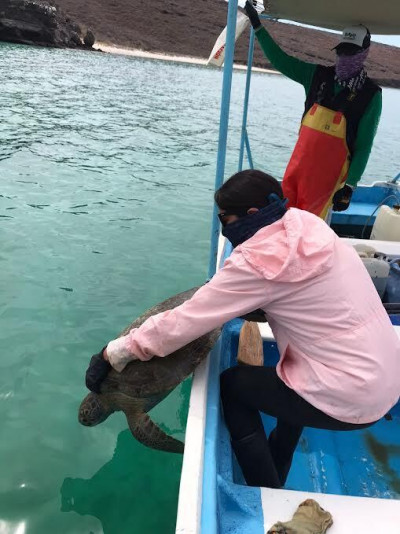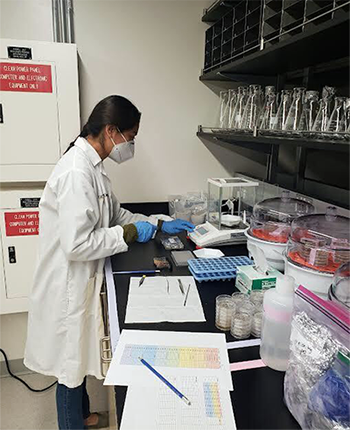Chanel Robles is currently in her final quarter of the Master of Advanced Studies program in Marine Biodiversity and Conservation (MAS MBC) at Scripps Institution of Oceanography at UC San Diego. Robles earned her bachelor’s degree in biology at UC Santa Cruz, where she additionally earned her master’s degree in education. Earlier this year, she worked in Scripps oceanographer Moira Décima’s lab, conducting independent research.
explorations now: Why did you choose to attend Scripps?
Chanel Robles: I chose to attend Scripps due to the interdisciplinary work and research being done. When looking at the course offerings, I saw that Scripps offered classes providing both academic and field experience. I had been looking into graduate programs that would allow me to grow on an academic and personal level. I feel very grateful to be learning from researchers and students that are passionate about the work they are doing.

en: What are you researching at Scripps?
CR: For my capstone project, I am working with Dr. Eduardo Reséndiz’s research team on a project called Health Assessments in Sea Turtles from Baja California Sur (HASTBCS), and working with graduate student Helena Fernández-Sanz from Universidad Autónoma de Baja California Sur (UABCS). Heidi Batchelor and Ernest Brazier of Scripps are also part of my capstone committee.
My research focuses on green sea turtles surrounding Isla Espíritu Santo (IES), Baja California Sur, México. I am compiling data from HASTBCS to assess the presence and abundance of green sea turtles around IES, in order to inform conservation efforts. Complementary to that data, I am conducting human research surveys on ecotourism guides operating out of La Paz, Baja Calif., to evaluate areas for future sea turtle monitoring. Using data gathered from both HASTBCS and the surveys, I will create a map using ArcGIS Pro—a desktop software for analysis of marine spatial data and map creation—to display and analyze areas with green sea turtle sightings.
en: How did you become interested in science and your field of study?
CR: The elders in my village in Oaxaca, México instilled great respect in me for the environment and life around me. Ever since I was little, I have always been interested in science. Larry Thibault, a high school science teacher who my mother worked with, encouraged my curiosity by inviting me to his classroom so that I could see what his students were learning. After learning that sea turtles could be consumed during my visits to Oaxaca, I wanted to learn more about their role in marine ecosystems and in our lives as consumers.
en: What’s life like as a Scripps student? Describe a typical day.
CR: Usually, I get up early in the morning and go for a walk, before going to class or studying in the Eckart Building. During the winter quarter, I would wake up early to do some work off of the Scripps Pier, and go to Moira Décima’s lab right after class. I also check my email throughout the day and like to take breaks walking around campus. I am currently in La Paz and attend UABCS to complete some of my capstone work, or work from home. When it comes to sea turtle monitoring, I get up early and go to the marina. The team and I leave around 7 a.m. and return at 4 p.m., after having visited different pre-established monitoring sites.
en: What’s the most exciting thing about your work (in the field or in the lab)?
CR: The most exciting part about my work is that I am always learning something new! I have always wanted to do research, and feel very happy and grateful to be collaborating with and learning from researchers from both Scripps and México. I enjoy being out in the field, analyzing data, and being able to get a better understanding of what is happening in the world.

en: Are there any role models or mentors who have helped you along the way?
CR: My family is full of women who have mentored and supported me in my education. The women at the Chicana Latina Foundation are an inspiration as well. My high school teacher, Anne Cappiello, has played a positive role in my life since I was her student. Lisa Storer, also a former teacher, likewise provided me with much support and guidance in the college application process. My family and I did not know how the school system functioned, since I was the first one in my family to attend college in the U.S.
en: What are some of the challenges you face as a student?
CR: Some of the weekly challenges and feelings I encounter are experiencing imposter syndrome and anxiety over the work I am going to be doing. However, some things that help are going for walks and talking with my family and friends from the MBC program.
en: What are your plans post-Scripps?
CR: I will be moving back to Santa Cruz, and would like to work on research that informs conservation efforts and policymaking. My ideal job would encompass research while working and learning from communities either in México or the United States. Integrating local ecological knowledge and Indigenous voices and perspectives in marine conservation is very important to me.
You can find Chanel on Instagram at @cs.robles and HASTBCS at @hastbcs.